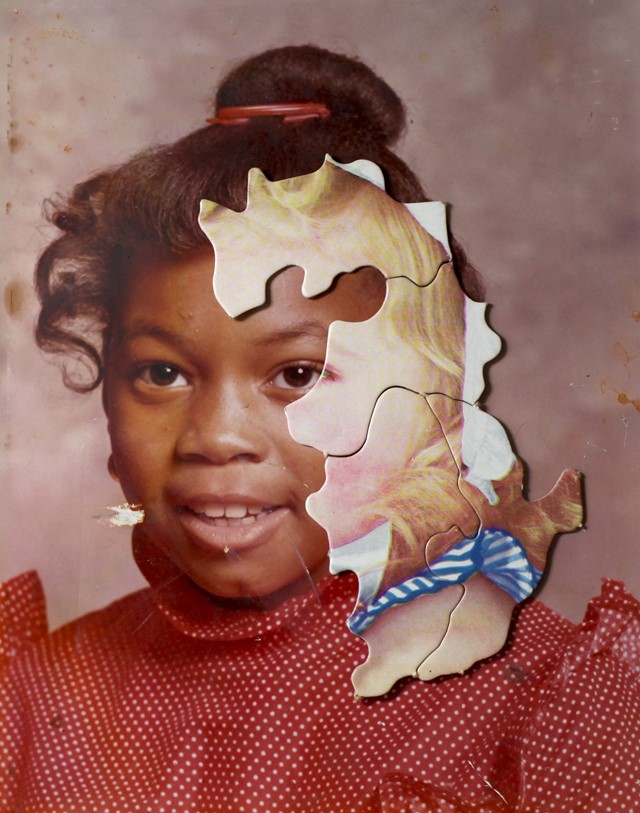Camille Lévêque is the founder of The Live Wild, a photographic collective formed of seven of her alter egos
This year AnOther Magazine partnered with Unseen Amsterdam to create a series of features around its spectacular 2017 edition. Here we celebrate three photographers and photography collectives we discovered there: second in this series is The Live Wild Collective.
Aliases have been used liberally throughout history to conceal the identity of their creators, or to allow a greater degree of flexibility in artistic work. Take Portuguese poet Fernando Pessoa, for example, who wrote under as many as 81 pseudonyms, or the Brontë sisters, who assumed neutral names in order to publish their works in a society which rejected female authors. It’s less common however to discover a whole art collective, seemingly comprising seven members, which turns out to represent the seven alternate identities of just one.
Such is the case for Live Wild, an art collective founded by French photographer Camille Lévêque in the summer of 2014. As she describes it, the set-up is simple. “Officially, there are seven members in Live Wild,” she tells AnOther, their names (Charlotte Fos, Anna Hahoutoff, Marguerite Horay, Ina Lounguine, Lucie Khahoutian, Lila Khosrovian: together forming an acrostic for ‘Camille’) and personal histories all drawn from members of her own family. “Informally, there is just one: myself.”
Lévêque was driven to found the collective by her frustration with the limits of her chosen genre. In her seven aliases, she has found the freedom to experiment with different media and techniques; the vivid works she produces range from off-kilter gifs and digitally distorted found images to photo collages and still life compositions. But more than simply practical, the invention of these characters is part of a wider socio-cultural narrative, permitting her to experiment with other identities and nationalities. We spoke to her to find out more.

On her alternate identities…
“The idea of fictional characters came quite naturally to me. Telling the stories of my family members, from which I borrowed and blended the name, I try to include their personality in each work, following a specific direction for each member, hence remaining relevant to their actual story, the places they lived in, the work they were doing or the choices they made.
“Every time I think of a new work I first think about whom it makes me think of amongst my aliases. This is also why some of them make more work than others. Lucie is quite productive, for example, as it’s a strong figure in my family. Marguerite is more discreet – I never met her and I don’t know much about her. I find myself dissociating from my aliases sometimes, as if they were real individuals – I end up being jealous of one or the other, for example, because their work has more success than ‘mine’. I also keep referring to ‘us’ as a real group, even to my family, which amuses me. It means I’m taking this alias thing rather seriously, I guess.
“With this collective I aim take myself completely out of my work, while at the same time constructing all my work around the idea of my own identity. Here, it does not matter where I come from, what gender or age I am, and where I went to school. The only thing that matters is the work produced, and understanding whether the work defines me, or if it is the other way around.”

On deciding not to go to art school…
“It is a choice I really don’t regret nowadays – I have more freedom and less pressure. I try things, I learn along the way, sometimes it works out, other times it doesn’t. Most people I meet that went to art school have a very specific way to see and speak about photography and their work. Their eye has been educated by a teacher or a structure and that bothers me a bit. Rare are the photographers I meet that are open to every genre of photography and that seems just insane to me. Some will just be really into black and white and that’s it, others will only like really crisp sharp images, other only conceptual works, and so on. It’s like they have a very clear visual identity they produce and are interested in which I think makes the work looks stronger but the artist weaker. You never grow if you constantly keep producing the same old thing.”

On the themes which underpin her practice…
“Faith, magic and religion are very present in my work. I find mystical matters in general very attractive – it’s a challenge to think about ways to illustrate something so abstract and sensitive. It’s also incredibly fascinating to work on topics that are at the same time universal and so personal. Memory, family and identity are a strong topic too. Coming from a multi-cultural background and being the granddaughter of a political refugee this heritage naturally became a great part of what I want to talk about, and what I need to remember.”






